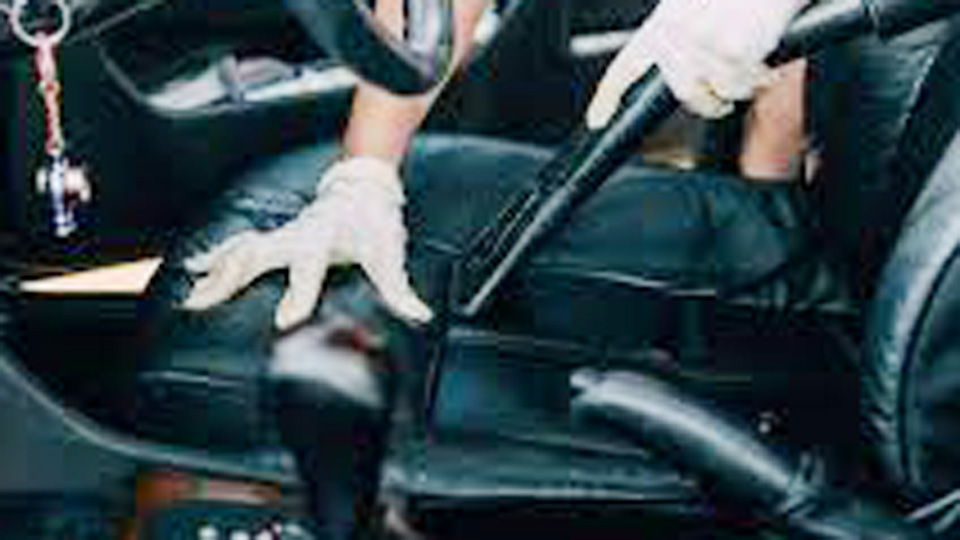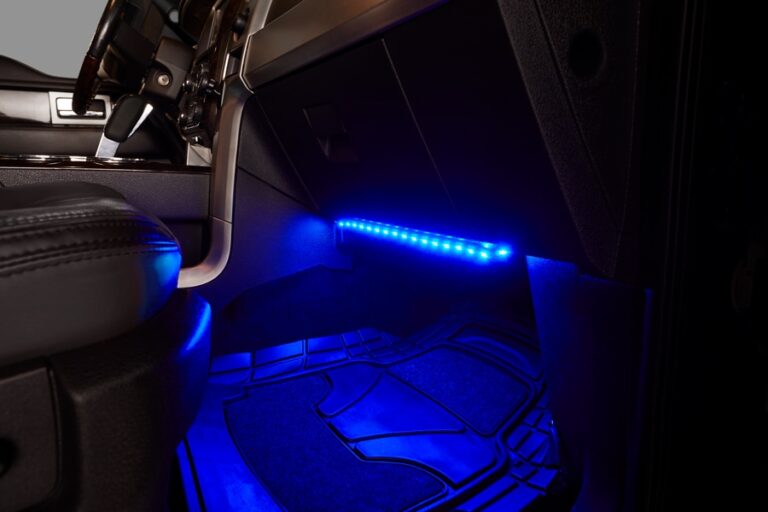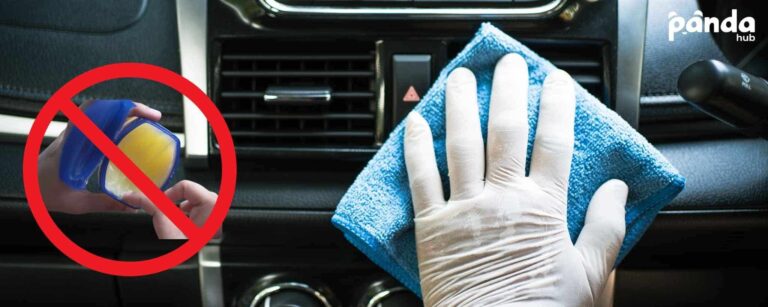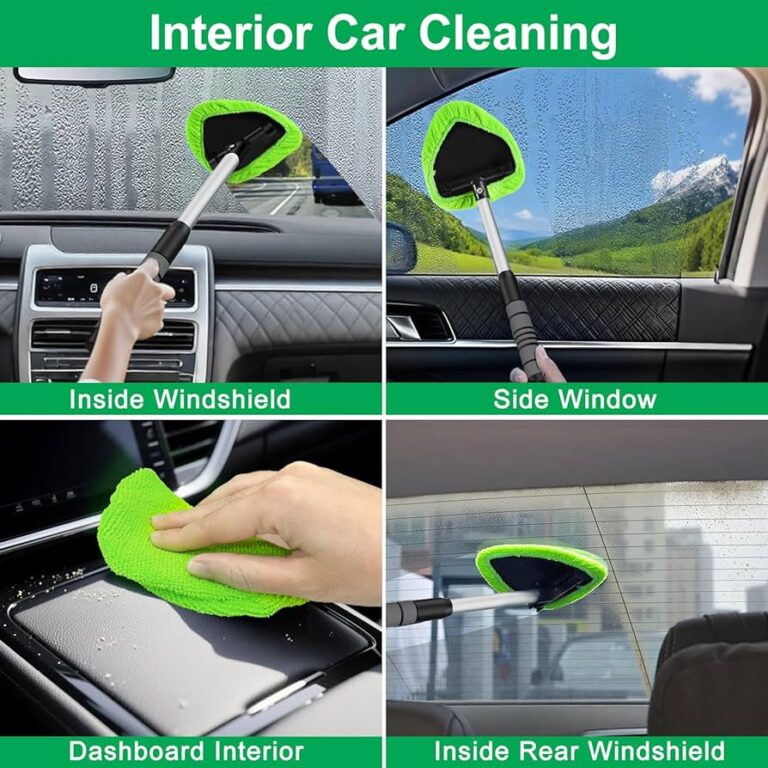A proper deep clean means hitting every corner—air vents, seat crevices, carpets, leather, and even those hidden spots under the seats where crumbs and dust love to hide. I’ve done full interior details in my garage more times than I can count, and the difference afterward is huge. Not only does the car look and smell fresh, but the materials last longer too—preventing cracks, fading, and premature wear.
The biggest mistake I see is people grabbing one generic cleaner and rushing through. Different surfaces need different care—steam or fabric cleaner for cloth seats, gentle pH-balanced products for leather, and soft brushes for vents and trim. Even the headliner needs special attention, since scrubbing it too hard can cause damage.
In this guide, I’ll walk you through step by step how to superclean your car interior the right way—what order to clean in, which products to use, and a few pro tricks I rely on to get that “like-new” finish. By the end, you’ll have a car interior that feels fresh, spotless, and ready to impress.

Image by realsimple
Why Supercleaning Your Car Interior Matters More Than You Think
First off, your car’s interior isn’t just a space—it’s a system of interconnected parts that affect your daily drive. From the dashboard that houses critical controls to the seats that support you for hours, keeping everything superclean boosts safety by ensuring clear visibility and grip, improves air quality for better health, and enhances resale value. I’ve had customers bring in cars where neglected interiors led to mold issues, reducing fuel efficiency indirectly through added weight from debris or even causing electrical shorts from spills.
In terms of cost, a thorough superclean can save you hundreds. For instance, regular maintenance prevents the need for premature replacements, like swapping out a worn carpet that could’ve been salvaged with deep cleaning. Reliability-wise, clean interiors mean fewer distractions— no sticky buttons or foggy windows from grime. And for fuel efficiency? A lighter, debris-free cabin means less strain on your engine, especially in heavy haulers like pickup trucks.
But here’s a personal tip from the shop: I once detailed a 2015 Ford F-150 where the owner thought the AC was failing. Turns out, it was just clogged vents from years of dust— a superclean fixed it without parts. That’s why this matters; it’s practical prevention.
Preparing for the Superclean: Tools and Safety Essentials
Before we dive in, let’s gear up. As someone who’s prepped hundreds of vehicles for detailing, I always start with the right tools to avoid damage. You’ll need a shop vac with attachments (I swear by the Craftsman models available at Lowe’s nationwide), microfiber cloths, interior cleaner (like Meguiar’s from AutoZone), leather conditioner if applicable, a soft-bristle brush, and compressed air for crevices. For safety, wear gloves to protect from chemicals, and work in a well-ventilated garage—fumes from cleaners can be harsh.
Common mistake? Skipping the prep. I’ve seen DIYers jump in without removing mats or trash, leading to uneven results. Pro tip: Park in shade to prevent streaks from quick-drying solutions. And always test cleaners on a small spot first—I’ve rescued a few vinyl dashes from discoloration this way.
Supercleaning the Dashboard and Console: The Heart of Your Cabin
The dashboard and center console are like the command center of your car—housing gauges, infotainment, and controls that you interact with constantly.
What the Dashboard and Console Do and Why They Get Dirty
These parts protect and display vital info while providing storage and connectivity. In US models like the Chevy Silverado, they’re often made of vinyl or plastic, prone to UV fading and dust buildup from road vibrations. Dirt accumulates from hands, spills, and airborne particles, leading to sticky surfaces that can distract drivers.
Common problems? Cracks from sun exposure or electrical issues from liquid ingress. Signs of failure include fading colors, warping, or malfunctioning buttons—I’ve diagnosed many “dead” radios that were just grimy connections.
When and Why Replacement Might Be Needed
If cleaning doesn’t cut it, like with deep cracks, replacement is key for safety—no one wants a dashboard airbag deployment issue. Replace when wear affects functionality, say every 10-15 years in high-sun states like California or Arizona.
OEM vs Aftermarket Options for Dashboard Components
OEM parts from manufacturers like GM or Ford ensure perfect fit but cost more—think $200-500 for a dash pad. Aftermarket from brands like Coverlay (widely available on Amazon) are cheaper ($100-300) and often include UV protection.
Here’s a quick comparison table:
| Aspect | OEM | Aftermarket (e.g., Coverlay) |
|---|---|---|
| Price | $200-500 | $100-300 |
| Fit & Quality | Exact match, high durability | Good fit, variable quality |
| Availability | Dealer only | Online/retail stores |
| Warranty | Factory | 1-2 years |
Pros of OEM: Seamless integration. Cons: Pricey. Aftermarket pros: Affordable custom colors. Cons: Potential fit issues.
Installation Tips, Maintenance, and Common Mistakes
For cleaning: Vacuum first, then wipe with a diluted all-purpose cleaner using microfiber. For replacement, disconnect battery for safety—I’ve done this on Jeeps where airbags are involved. Maintenance? Use UV protectant sprays weekly. Mistake to avoid: Harsh chemicals that crack vinyl—I learned that the hard way on a ’90s Honda.
Personal anecdote: In my shop, a client with a dusty Tesla Model 3 thought the touchscreen was failing. A superclean with electronics-safe wipes revived it—no replacement needed.
Tackling Seats and Upholstery: Where Comfort Meets Durability
Seats are the most used “part” in your interior, absorbing sweat, spills, and wear daily.
Understanding Seats and Their Role
Whether cloth in economy cars like the Toyota Corolla or leather in luxury like Cadillacs, seats provide support and safety via integrated belts and airbags. They get dirty from body oils, food, and pets, leading to odors and stains.
Common issues: Tears, fading, or sagging foam. Signs? Uncomfortable rides or visible damage—I’ve seen seats cause back pain from neglected grime.
Signs It’s Time for Replacement or Deep Clean
Deep clean annually, but replace if foam compresses (common after 100k miles) or fabric frays, affecting crash safety.
Choosing Between OEM and Aftermarket Seat Options
OEM seats from dealers match perfectly but run $500-1500 per seat. Aftermarket like Katzkin kits (popular in the US) offer leather upgrades for $800-1200, compatible with most domestics.
Comparison table:
| Feature | OEM | Aftermarket (e.g., Katzkin) |
|---|---|---|
| Cost | $500-1500 | $800-1200 |
| Material Quality | Factory spec | Customizable, durable |
| Installation | Professional recommended | DIY-friendly kits |
| Compatibility | Vehicle-specific | Broad US models |
OEM pros: Authenticity. Cons: Wait times. Aftermarket pros: Upgrades like heated options. Cons: Voided warranties if not careful.
Step-by-Step Supercleaning and Replacement Insights
Start by vacuuming crevices, then spot-clean stains with upholstery shampoo—use a steam cleaner for deep penetration. For leather, condition after. Installation tip: For covers, align seams carefully; I’ve helped buddies install them on Wranglers without tools beyond a hog ring plier.
Maintenance: Vacuum weekly, treat spills immediately. Common mistake: Over-wetting cloth, leading to mold—air dry thoroughly.
Workshop story: A young driver brought in a Subaru with pet hair everywhere. After supercleaning, we added aftermarket covers—transformed the ride, and he avoided a full reupholster.
Deep Cleaning Carpets and Floor Mats: The Foundation of a Fresh Interior
Carpets and mats trap the worst—dirt, mud, and moisture that can lead to rust if ignored.
What Carpets and Mats Are For
They insulate, reduce noise, and protect the floorpan. In trucks like the Ram 1500, they’re rugged but collect grime fast from boots.
Problems: Stains, odors, or wear holes. Signs of failure: Musty smells or visible thinning—indicating potential floor rust.
When to Replace Instead of Just Cleaning
Clean seasonally, but replace if water damage causes delamination, common in flood-prone areas like Florida.
OEM vs Aftermarket Carpet and Mat Choices
OEM carpets from AutoZone or dealers cost $200-400, exact fit. Aftermarket like Husky liners (Walmart staples) are $100-200, weatherproof.
Table:
| Category | OEM | Aftermarket (e.g., Husky) |
|---|---|---|
| Price | $200-400 | $100-200 |
| Durability | Standard | All-weather resistant |
| Ease of Clean | Machine washable some | Hose off |
| US Availability | Dealers | Big box stores |
OEM pros: Color match. Cons: Less protection. Aftermarket pros: Custom fit for models like F-150. Cons: May not feel premium.
Hands-On Cleaning Guide and Tips
Remove mats, vacuum, then shampoo with a extractor tool—hang to dry. For replacement, pull old carpet carefully to avoid wiring damage. Tools: Trim removal kit, shop vac.
Maintenance: Use mats over carpet. Mistake: Ignoring under-mat moisture—I’ve pulled rusted floors from that.
Anecdote: Fixed a VW Jetta where soggy carpets hid rust. Superclean and new mats saved the body.
Revitalizing the Headliner and Ceiling: Often Overlooked but Crucial
The headliner is the “roof” of your interior, sagging or staining easily.
Function and Common Dirt Buildup
It insulates and hides wiring; smoke or leaks cause yellowing.
Issues: Sagging glue failure. Signs: Drooping fabric—safety hazard if obstructing view.
Replacement Triggers
Clean gently, but replace if adhesive fails, every 10 years in humid climates.
OEM and Aftermarket Headliner Kits
OEM fabric $300-600. Aftermarket from Headliner Express $150-400, DIY kits.
Table:
| Aspect | OEM | Aftermarket |
|---|---|---|
| Cost | $300-600 | $150-400 |
| Material | Original | Variety of fabrics |
| Install Difficulty | High | Moderate with glue |
| Brands | Dealer | Online specialists |
Pros/cons similar: OEM exact, aftermarket affordable.
Cleaning Steps and Pro Insights
Wipe with mild soap; for sags, re-glue. Tools: Adhesive spray. Mistake: Pulling too hard, tearing foam.
Story: Refreshed a Camaro headliner—owner thought it was junk, but clean and repair did the trick.
Windows, Mirrors, and Trim: For Crystal-Clear Visibility
These ensure safety through clear sightlines.
Role and Grime Issues
Glass and plastic trim fog from films; common in smokers’ cars.
Problems: Streaks, haze. Signs: Reduced visibility.
When to Replace Trim or Glass
Clean first; replace scratched mirrors ($50-200).
Options for Replacement
OEM mirrors from RockAuto. Aftermarket like Dorman.
Table:
| Type | OEM | Aftermarket (Dorman) |
|---|---|---|
| Price | $100-300 | $50-200 |
| Quality | High | Reliable |
| Fit | Perfect | Good for most US cars |
Cleaning and Maintenance
Use glass cleaner, clay bar for haze. Tip: Newspaper for streak-free.
Anecdote: Cleared up a foggy BMW—simple clean avoided mirror swap.
Air Vents and HVAC System: Breathing Easy in Your Ride
Vents circulate air; dust clogs them.
What They Do
Filter and direct airflow; poor clean affects AC efficiency.
Issues: Mold, reduced flow.
Replacement Needs
Clean filters yearly; replace if damaged.
OEM vs Aftermarket Filters
OEM like Fram $20-40. Aftermarket K&N reusable.
Table:
| Filter | OEM | Aftermarket (K&N) |
|---|---|---|
| Cost | $20-40 | $30-50 |
| Type | Disposable | Washable |
| Efficiency | Standard | High-flow |
Cleaning Guide
Compressed air, then foam cleaner. Mistake: Ignoring cabin filter.
Story: Boosted AC in a Honda by cleaning vents—no parts needed.
Identifying Genuine vs Fake Parts During Upgrades
When replacing during a superclean, watch for fakes. Genuine OEM has holograms, proper packaging. Fakes lack detail—I’ve spotted counterfeits in alternator covers. Buy from trusted US spots like NAPA or O’Reilly.
Conclusion: Keeping Your Interior Superclean for the Long Haul
Wrapping this up, supercleaning your car interior is about more than looks—it’s smart maintenance that saves money, boosts safety, and keeps your ride reliable. By tackling each part methodically, you’ll spot issues early, choose wisely between OEM and aftermarket, and avoid common pitfalls. Make smarter decisions by assessing wear during cleans and opting for quality brands compatible with your vehicle.
How Often Should I Superclean My Car Interior?
Aim for every 3-6 months, more if you have pets or kids. In dusty areas like Texas, monthly vacuums help.
What’s the Best Cleaner for Leather Seats?
Use pH-balanced like Lexol—I’ve used it on countless luxury cars without damage.
Can I Use Household Products for Interior Cleaning?
Yes, diluted vinegar for glass, but avoid on leather—stick to auto-specific for safety.
How Do I Remove Pet Hair from Upholstery?
Rubber gloves or a lint roller works wonders; steam for stubborn spots.
When Should I Replace Floor Mats Instead of Cleaning?
If cracked or odor-trapped beyond shampooing, swap for all-weather like WeatherTech for US winters.



